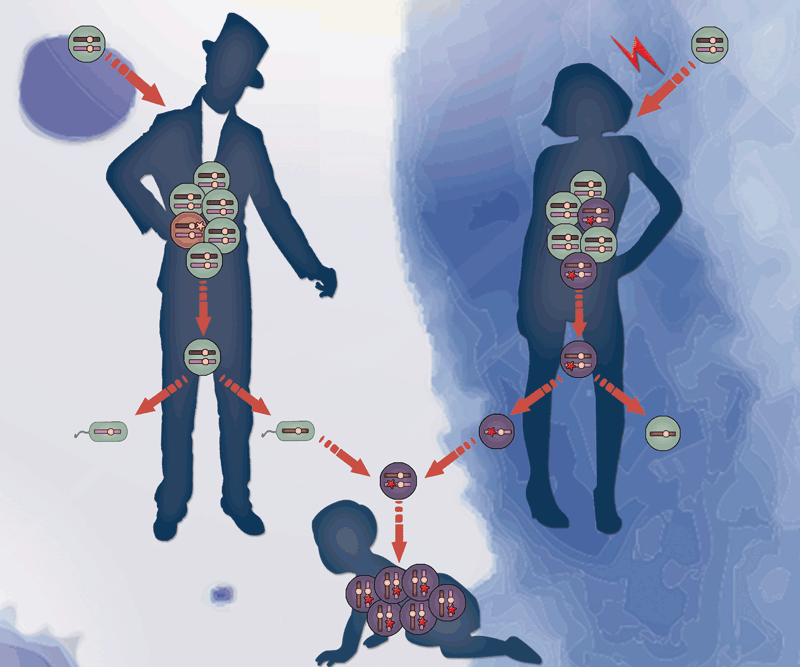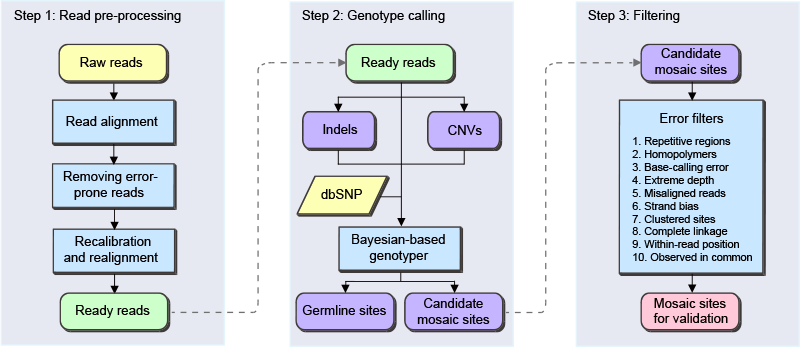About the project:
What is genomic mosaicism?
Genomic mosaicism is a biological phenomenon in which genetic alterations occurring during development or aging give rise to two or more cell populations with distinct genome sequences within one individual. The DNA alterations in a fraction of somatic and/or germ cells can occur at different genomic scales, varying from chromosomal abnormalities and copy number variations to small indels and single-nucleotide substitutions.
Previous studies have discovered the role of mosaicism in multiple types of cancer as well as increasing number of non-cancer diseases including Proteus syndrome, Ollier disease and Maffucci syndrome, CLOVES syndrome, Schimmelpenning syndrome, Sturge-Weber syndrome, and several types of brain malformations. It has also been detected in healthy individuals including healthy parents of children affected with genetic disorders, highlighting its critical role in the origin of genetic mutations.
According to the timing and cell lineage the postzygotic mutation occurred, the mutant allele could be observed in a fraction of somatic and / or germ cells. It has been showed that a clinically unremarkable carrier of a deleterious postzygotic mutation might transmit it to offspring and generate a heterozygous genotype that may cause serious genetic diseases. Due to the limited detection power of Sanger sequencing and conventional NGS-based genotypers, some of the pathogenic genetic mutations currently believed to emerge de novo in affected children might be actually transmitted from undetected parental mosaicism.
Based on previous cancer studies concerning cancer somatic mutations and familial de novo mutations, single-nucleotide mutation is the most predominant type of DNA alteration in the human genome.If we know the genomic positions of single-nucleotide mosaicisms (SNMs), they could be validated by various types of low-throughput methods including Sanger sequencing, pyrosequencing and sequencing of clonal fragments.The advance of high-throughput next-generation sequencing (NGS) technologies enabled us to de novo identify SNMs at genomic scale.
 |
| Genomic mosaicism led by acquired postzygotic mutations transmits to the offsprin |
Detecting mosaicism of postzygotic single-nucleotide mutations
However, due to the difficulties to distinguish postzygotic mosaic sites from large numbers of inherited homozygous and heterozygous sites and technical artifacts led by sequencing and alignment errors, existing tools to identify SNMs from NGS data usually require the "affected-normal" tissue pairs obtained from the same person.MosaicHunter is designed to identify SNMs from whole-genome or whole exome sequencing of unpaired control-free samples, and also able to adapte the sequencing data of parental samples or paired control samples obtained from the same individual.
 |
| Working flowchart of MosaicHunter |
Reference
1.Lupski JR. Genome Mosaicism - One Human, Multiple Genomes. Science 2013; 341:358-359.
2.Biesecker LG, Spinner NB. A genomic view of mosaicism and human disease. Nat Rev Genet 2013; 14:307-320.
3.Huang Y et al. Postzygotic single-nucleotide mosaicisms in whole-genome sequences of clinically unremarkable individuals. Cell Res 2014; 24:1311-1327.
4.Xu X et al. Amplicon resequencing identified parental mosaicism for approximately 10% of "de novo" SCN1A mutations in children with Dravet syndrome. Hum Mutat 2015; 36:861-872.


